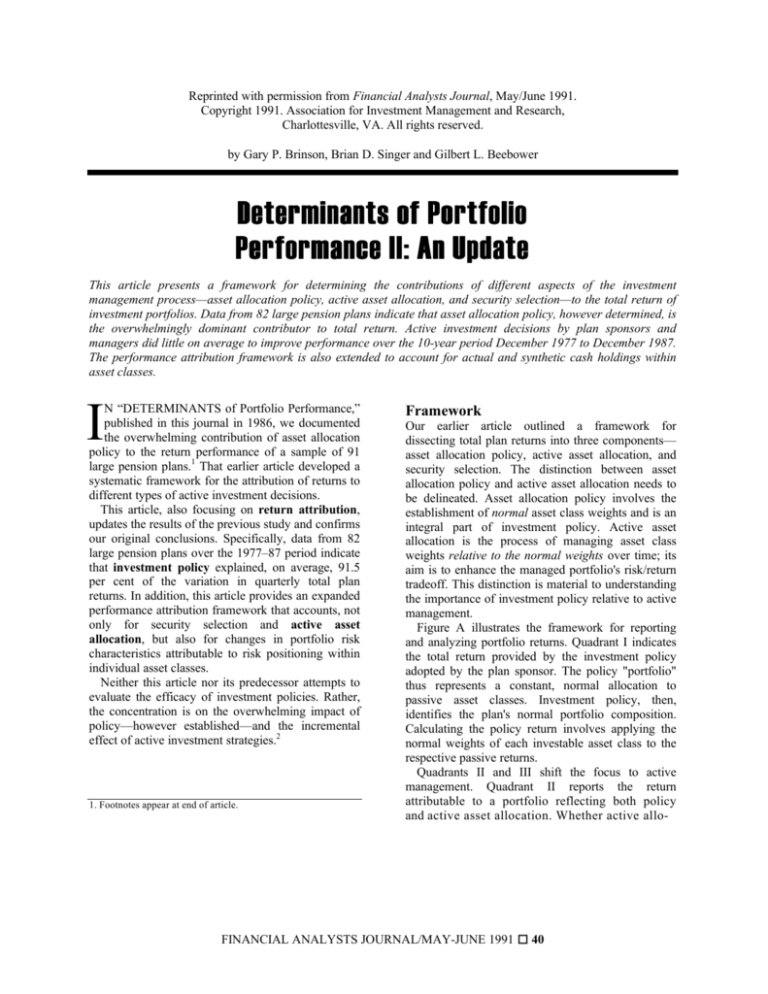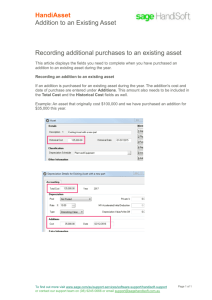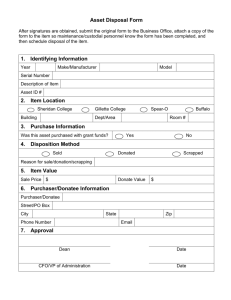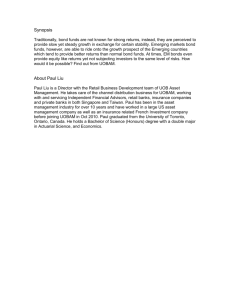
Reprinted with permission from Financial Analysts Journal, May/June 1991.
Copyright 1991. Association for Investment Management and Research,
Charlottesville, VA. All rights reserved.
by Gary P. Brinson, Brian D. Singer and Gilbert L. Beebower
Determinants of Portfolio
Performance II: An Update
This article presents a framework for determining the contributions of different aspects of the investment
management process—asset allocation policy, active asset allocation, and security selection—to the total return of
investment portfolios. Data from 82 large pension plans indicate that asset allocation policy, however determined, is
the overwhelmingly dominant contributor to total return. Active investment decisions by plan sponsors and
managers did little on average to improve performance over the 10-year period December 1977 to December 1987.
The performance attribution framework is also extended to account for actual and synthetic cash holdings within
asset classes.
I
N “DETERMINANTS of Portfolio Performance,”
published in this journal in 1986, we documented
the overwhelming contribution of asset allocation
policy to the return performance of a sample of 91
large pension plans.1 That earlier article developed a
systematic framework for the attribution of returns to
different types of active investment decisions.
This article, also focusing on return attribution,
updates the results of the previous study and confirms
our original conclusions. Specifically, data from 82
large pension plans over the 1977–87 period indicate
that investment policy explained, on average, 91.5
per cent of the variation in quarterly total plan
returns. In addition, this article provides an expanded
performance attribution framework that accounts, not
only for security selection and active asset
allocation, but also for changes in portfolio risk
characteristics attributable to risk positioning within
individual asset classes.
Neither this article nor its predecessor attempts to
evaluate the efficacy of investment policies. Rather,
the concentration is on the overwhelming impact of
policy—however established—and the incremental
effect of active investment strategies.2
1. Footnotes appear at end of article.
Framework
Our earlier article outlined a framework for
dissecting total plan returns into three components—
asset allocation policy, active asset allocation, and
security selection. The distinction between asset
allocation policy and active asset allocation needs to
be delineated. Asset allocation policy involves the
establishment of normal asset class weights and is an
integral part of investment policy. Active asset
allocation is the process of managing asset class
weights relative to the normal weights over time; its
aim is to enhance the managed portfolio's risk/return
tradeoff. This distinction is material to understanding
the importance of investment policy relative to active
management.
Figure A illustrates the framework for reporting
and analyzing portfolio returns. Quadrant I indicates
the total return provided by the investment policy
adopted by the plan sponsor. The policy "portfolio"
thus represents a constant, normal allocation to
passive asset classes. Investment policy, then,
identifies the plan's normal portfolio composition.
Calculating the policy return involves applying the
normal weights of each investable asset class to the
respective passive returns.
Quadrants II and III shift the focus to active
management. Quadrant II reports the return
attributable to a portfolio reflecting both policy
and active asset allocation. Whether active allo-
FINANCIAL ANALYSTS JOURNAL/MAY-JUNE 1991
40
Figure A
Actual
IV
Actual
Portfolio
Return
II
Policy and
Active Asset
Allocation
Return
Passive
III
Policy and
Security
Selection
Return
I
Policy Return
(Passive
Portfolio
Benchmark)
Active Returns Due to:
Active Asset Allocation
Security Selection
Other
II – I
III – I
IV - III - II + I
Total
IV – I
asset class. This framework specifies that the return
from policy and security selection is obtained by
applying the normal asset class weights to the actual
active returns achieved in each asset class.
Finally, Quadrant IV represents the actual return
realized by the plan over the period of performance
evaluation. This is the result of the plan's actual asset
class weights interacting with the actual asset class
returns.
Figure B summarizes the calculations required to
determine the returns for Quadrants I, II and
Figure B
Computational Requirements for
Return Accountability*
Actual
Security Selection
Actual
Passive
∑ (Wai • Rai)
Passive
cation involves anticipating price moves (market
timing) or reacting to market disequilibria
(fundamental analysis), it results in the under or
overweighting of asset classes relative to the normal
weights identified by policy.3 The aim of active
allocation is to enhance the return and/or reduce the
risk of the portfolio relative to its policy benc
hmark.
The policy and active asset allocation return is
computed by applying the actual asset class weights
to their respective passive benchmark returns.
Quadrant III presents the returns to a portfolio
attributable to policy and security selection.
Security selection involves active investment
decisions concerning the securities within each
A Simplified Framework for
Return Accountability
Security Selection
Actual
Passive
Asset Allocation
Return Attribution: The process of attributing
actual portfolio return to those investment
management activities that contribute to the
return—investment policy, active asset allocation
and security selection.
Investment Policy: Specification of the plan
sponsor's objectives, constraints and requirements,
including identification of the normal asset
allocation mix.
Active Asset Allocation: Temporarily deviating
from the policy asset mix in order to benefit from a
state of capital market disequilibrium with respect
to the investment fundamentals underlying the
policy mix.
Coefficients of Determination: The percentage of
variability in one random variable that is accounted
for by another random variable. The more familiar
R2, indicating the variability of the dependent
variable accounted for by a regression model, is
identical to the coefficient of determination for
univariate regressions.
Risk Positioning: The active allocation out of noncash assets into cash equivalents at the sset
a
allocation level and the holding of cash within an
asset class portfolio.
External Risk Positioning:The allocation into and
out of cash-equivalent assets. The term "external"
refers to positioning at the asset class level. As
segregating the cash component at the asset class
level is a rather common aspect of active asset
allocation performance attribution, "external risk
positioning" is used in a broader sense to mean
active asset allocation.
Internal Risk Positioning:The establishment of a
position in actual or synthetic cash, typically to
control beta or duration risk, within an asset class.
The term "internal" refers to positioning within an
asset class.
Asset Allocation
Glossary
∑ (Wpi • Rai)
IV
i
III
i
II
∑ (Wai • Rpi)
i
I
∑ (Wpi • Rpi)
i
*Wpi = policy weight for asset class i; Wai = actual ewight for
asset class i; Rpi = passive return for asset class i; Rai = actual
return for asset class i.
FINANCIAL ANALYSTS JOURNAL/MAY
-JUNE 1991 o 41
Table I
Calculation of Active Contributions to Total
Performance
Return Due to
Calculated By
∑ [(Wai * Rpi) – (Wpi * Rpi)]
Active Asset
Allocation
i
Security Selection
(Quadrant II – Quadrant I)
∑ [(Wpi * Rai) – (Wpi * Rpi)]
i
(Quadrant III – Quadrant I)
∑ [Wai – Wpi) (Rai – Rpi)]
Other
i
[Quadrant IV – (Quadrant II
+ Quadrant III) + Quadrant I]
∑ [(Wai * Rai) – (Wpi * Rpi)]
Total
i
(Quadrant IV – Quadrant I)
III. Table I provides the computational methodology
for determining the sources of active returns. The
active contribution to total performance is composed
of active asset allocation, security selection, and the
effects of a cross-product term that measures the
interaction of the security selection and active asset
allocation decisions.
Data
Attributing returns to the various aspects of the
investment process according to this frame-work
requires historical data on portfolio composition
(weights), actual investment results, and returns
to the appropriate benchmarks. SEI Corporation
provided 10 years of quarterly data, from
December 1977 to December 1987, for 82
pension plans in their Large Plan Universe. The
seven series available for each plan were four
Figure C
asset-class-weight series for equity, bonds, cash
equivalents and "other" and three quarterly rate-ofreturn series for the total plan and its associated
equity and bond components. The focus of this
article is on investment performance, so all returns
were expressed gross of management fees.
An analysis of the asset class weights indicates
that there was no significant shift in asset class
preferences over the period covered by the sample
data. Figure C demonstrates that the average
weights of the asset classes for the sample
remained remarkably stable over time, despite
market trends and volatility. This is somewhat at
odds with other surveys showing increased
exposure to equities over similar periods.4
Because the composition of the "other assets"
category was unknown, its weight was allocated
to the equity, bond and cash components in
proportion to their respective weights. Table II
shows that this component constituted a
relatively small percentage (less than 15 per
cent) of total plan assets and did not materially
affect total plan returns. However, a few plans
had extraordinarily large allocations to the
"other" category over the period; these "outliers"
were omitted from the analysis. None of the
sample funds held non-U.S. bonds, and only two
held non-U.S. equity. In these cases, the foreign
equity was considered part of the equity
component, without a material effect on the
results.
We defined policy weights for each plan (the
Average Asset Class Weights, 1977–1987
Source: SEI Corporation
FINANCIAL ANALYSTS JOURNAL/MAY-JUNE 1991
42
Table II
Analysis of Asset Class Weights, 82 Large Pension Plans, 1977-1987
Summary of Holdings
Equity
Bond
Cash
Other
Average
53.0%
24.5%
12.1%
10.5%
Equity
Bond
Cash
Average
59.6%
26.9%
13.6%
Maximum
79.1%
53.1%
24.1%
65.4%
Summary of Holdings Excluding "Other"
normal weights) as the 10-year average of the plan's
asset class weights. These funds did not necessarily
favor a "typical" mix of assets (such as 60/40
stocks/bonds), although, as Table II shows, the
average mix was very close to 60 per cent equity
and 40 per cent fixed income. Figure D shows that
the observed combinations of equity and bond
weights cover almost the whole range of
possibilities.
Some plans showed evidence of a change in
policy over the 10 years, either by a clear upward or
downward trend in the weight of an asset class or a
sudden and apparently permanent shift in the level of
the quarterly weights. We attempted to account for
this in the analysis. In cases where there appeared to
be a policy shift, we divided the 10-year period into
two periods—prechange and postchange—and calFigure D
Maximum
83.9%
54.0%
24.3%
Minimum
26.0%
4.0%
3.0%
0.1%
Standard
Deviation
10.8%
10.4%
4.6%
12.0%
Minimum
36.5%
5.6%
3.5%
Standard
Deviation
10.5%
10.2%
4.9%
culated returns based on the policy weights in effect
in each period.
Results
In addition to the actual reported return for each plan,
we defined three return series—policy, policy and
active asset allocation, and policy and security
selection. The policy return is the passive portfolio
benchmark return, calculated as the sum of the policy
weighted passive asset class returns, using the 10year average asset class weights (as discussed above)
and a suitable passive index for each asset class. The
S&P 500, the Salomon Broad Investment Grade
(BIG) bond index and 30-day Treasury bills were
used as the passive indexes for the equity, bond and
cash components, respectively.
The policy and active asset allocation return is
Average Equity Weight versus Average Bond Weight, 1977–1987
Source: SEI Corporation
FINANCIAL ANALYSTS JOURNAL/MAY-JUNE 1991
43
Figure E
Mean Annualized Returns by Activity,
82 Large Pension Plans, 1977-1987
Actual
IV
13.41%
II
13.23%
Passive
Asset Allocation
Security Selection
Actual
Passive
III
13.75%
I
13.49%
Active Returns Due to:
Active Asset Allocation
Security Selection
Other
Total
–0.26%
+0.26%
–0.07%
–0.08%
calculated using the actual active weights and the
appropriate passive index returns. The policy and
security selection return is calculated using the policy
weights and the actual active returns. We repeated
each analysis using a broader market index than the
S&P 500; the results were virtually identical.
The overall effect of active management by plan
sponsors or investment managers was negligible.
This confirms the findings of our earlier study. Figure
E and Table III show that the average portfolio
underperformed its policy benchmark by eight basis
points a year.
Individual effects varied widely, from a 3.4 per
cent per annum underperformance to a 6.7 per cent
per annum overperformance. The incremental
return
to
active
management
had
a
Table III
standard deviation of 1.7 per cent. Clearly the
contribution of active management is not statistically
different from zero (that is, it is most likely
attributable to chance). While active asset
allocation contributed a net underperformance of
26 basis points, and security selection contributed
a gain of 26 basis points, neither figure is
statistically different from zero.
Active management not only had no measurable
impact on returns, but (in the absence of a proxy
for the variability of the respective pension
liabilities), it appears to have increased risk by a
small margin (Figure F and Table III). Given the
higher risk level of the policy and security
selection portfolio, it is evident that security
selection contributed to actual plan risk. Active
asset allocation appears to have had a negligible
impact on risk relative to the benchmark policy.
The
imperfect
correlation
between
the
performances of the policy and allocation and
the policy and security selection portfolios
mitigated some of the increased risk.
None of these observations detracts from the
finding that the choice of investment policy
dominates the risk/return posture of the plan. It
is obvious that the overwhelming factor in
determining the basic, long-term return
achieved per unit of risk was investment policy.
Because active asset allocation is the process
of managing asset class weights relative to the
normal
weights,
active
management
is
conditional on the investment policy. Thus
active returns are conditionally distributed on
the policy return distribution. This dominance is
also demonstrated by the coefficients of
determination for policy, policy and active
asset allocation, policy and security selection,
and active returns.
The coefficient of determination is the square
Annualized Returns and Risk by Activity, 1977–1987
Average
Return
Portfolio
Policy
Policy and Active A/A
Policy and Selection
Actual Portfolio
Active Return Components
Active A/A Only
Selection Only
Other
Total Active Return
13.49
13.23
13.75
13.41
–0.26
+0.26
–0.07
–0.08
Average
Risk
11.42
11.56
13.75
11.65
Return
Minimum
Return
Maximum
X-Sec.
Std. Dev.
12.43
11.26
10.52
10.34
14.56
15.09
19.32
19.95
0.49
0.68
1.66
1.75
–1.81
–3.32
–3.50
–3.43
0.86
6.12
1.33
6.73
0.47
1.52
0.80
1.67
FINANCIAL ANALYSTS JOURNAL/MAY-JUNE 1991
44
Figure F
Policy Risk versus Active Risk, 1977-1987
Source: SEI Corporation
both stock and bond components over the entire 10
years.
There are several possible explanations for these
irregularities. First, the analysis did not account for
the liability exposure of each plan. The inclusion of a
liability proxy might shift these performance
statistics. Second, the use of 10-year average weights
for the passive benchmark may have created an
inefficient benchFigure G
Percentage of Variation Explained,
1977–1987
Security Selection
Actual
Passive
Asset Allocation
Passive Actual
of the correlation coefficient between two jointly
distributed random variables. It is used to describe
the amount of variability in one variable that can be
accounted for by another variable. In this instance,
we are concerned with the percentage of variability in
actual returns that is accounted for by policy, by
policy and active asset allocation, and by policy and
security selection.
Figure G shows that, on average, policy returns
accounted for 91.5 per cent of the variance of actual
returns. Being conditionally distributed on the policy
returns, active asset allocation and security selection
combined could have accounted for only a small
residual portion of the variance of actual returns. In
fact, policy and active asset allocation combined
accounted for 93.3 per cent and policy and security
selection combined accounted for about 96.1 per
cent. Again, the dominance of investment policy is
clear.5
Although each level of risk was associated with a
range of plan returns, active returns generally
increased with plan risk. Figure H shows that, for a
given risk level, the difference in performance
between the best and the worst plans was as much as
3 per cent annually. The two plans with
extraordinarily low risk had higher allocations to the
"other asset" class—perhaps real estate, given the low
volatility. Three other plans had unusually strong
returns, with each showing extraordinary returns from
IV
100.0%
II
93.3%
III
96.1%
I
91.5%
Average
Minimum
Maximum
Std. Dev.
Policy
91.5%
67.7%
98.2%
6.6%
Policy and Allocation
93.3%
69.4%
98.3%
5.2%
Policy and Selection
96.1%
76.2%
99.8%
5.2%
FINANCIAL ANALYSTS JOURNAL/MAY-JUNE 1991
45
Figure H
Average Return versus Average Plan Risk, 1977-1987
Source: SEI Corporation
mark. While the impact was probably not great, some
bias was introduced.
It is difficult, given these data, to determine
conclusively which asset classes generated good or
bad relative performance. It should be noted,
however, that 76 of the 82 equity funds
underperformed the S&P 500 on an equity-only
basis. A complete 10-year bond performance was not
available for several funds, because their bond
weights were zero for several quarters. For the 70
cases with complete bond histories, almost two-thirds
outperformed the passive bond benchmark. Of those
plans that underperformed their policy benchmarks,
over 75 per cent underperformed in the bond
component. As one would expect, the median cash
manager outperformed the 30-day T-bill index.
Limitations
Our analysis lacks some precision because of
performance data limitations. First, as noted, the
composition of the "other asset" category was
unknown; in many cases, however, this category
constituted only a small percentage of the total
portfolio. Second, policy portfolios were inferred
from the long-term average asset class weights, and
there is no assurance that they reliably represent the
actual benchmarks. In terms of assessing the
importance of the benchmark to investment returns,
however, this is probably not a serious problem.
Adjusting for apparent shifts in policy weights
had very little effect on the analysis. In fact, using a
simple 60/40 stock/bond mix as a passive benchmark
for all the funds resulted in virtually the same
average results as indicated in Figure G. Given the
average portfolio composition in Table II, this is not
too surprising.
Finally, we do not know the actual number of
different money managers used by these 82 pension
plans. While it is highly unlikely that the data
represent only a few managers, the study does reflect
the performance of individual managers, not
necessarily pension fund performance in general.
Furthermore, we know nothing about the styles of the
managers or their use of futures and options. Some
almost certainly altered internal risk positions by
hedging during the last quarter of 1987; this is
indicated by the positive equity returns at a time
when the market as a whole was down by almost 25
per cent. The issue of hedging, and the broader issue
of risk positioning, is treated in more depth below.
Internal versus External Risk Positioning
Besides shifting asset class weights—i.e., external
risk positioning—a manager or sponsor can change
exposure to an asset class within a portfolio
component—internal risk positioning. Internal
methods include altering the component's beta or
duration by using long or short futures positions,
carrying cash or hedging the currency
component. Looking at any single riskpositioning activity, external or internal, will not
FINANCIAL ANALYSTS JOURNAL/MAY-JUNE 1991
46
Table IV
Attribution of Internal and External Risk Positioning
Equation (1)
(Ra – Rp)Wp
(Wa – Wp)(Rp – R)
(Wa – Wp)(Rp – R)
0
0
(Wa – Wp)(Ra – Rp)
Security Selection
Risk Positioning
External
Internal
Cross Product
Cross Product
give a complete or accurate measure of the active
portfolio management effect.
The performance-attribution framework outlined
above defines the extra return, E, to a multi-asset
portfolio attributable to a particular asset class as:
E = (Ra – Rp)Wp + (Wa – Wp)(Rp – R)
+ (Wa – Wp)(Ra – Rp),
(1)
where
WP = the normal weight of the asset class,
Wa = the actual weight,
Rp = the total passive return on the asset class
index,
Ra = the total active return on the asset class, and
R = the total portfolio benchmark return.
The first term on the right-hand side of Equation (1)
defines the contribution of security selection and the
second gives the portion attributable to external risk
positioning (active asset allocation). The third term
isolates the interaction of security selection and
allocation. Within this definition of return, the
contribution of risk positioning is limited to changes
in the weights of asset classes.
This is an unnecessary constraint. We can
subdivide the actual active return on each asset class
into a pure selection component, Rs— indicating the
equity-only return—and a component that isolates the
effect of internal risk positioning, Rh—indicating the
actual or synthetic cash return:
Ra = (1 – c)Rs + cRh,
(2)
where c equals the proportion of the fund held in
cash. Inserting Equation (2) into Equation (1)
provides a framework for determining the effect of
asset class performance, in terms of both security
selection and explicit internal risk activity, on the
extra return of the entire portfolio:
Equation (3)
(Rs – Rp)Wp
(Wa – Wp)(Rp – R) + c(Rh – Rp)Wa
(Wa – Wp)(Rp – R)
c(Rh – Rp)Wp
c(Wa – Wp)(Rh – Rp)
[(1 – c)Wa – Wp](Rs – Rp)
E = (Rs – Rp)Wp + [(Wa – Wp)(Rp – R)
+ c(Rh – Rp)Wa] + [(1 – c)Wa – Wp]
(Rs – Rp).
(3)
Table IV compares Equations (1) and (3), showing
the contribution to the extra return of a multi-asset
portfolio from security selection, active asset
allocation (external risk positioning) and internal risk
positioning. The effect of internal risk positioning
indicated in the table is equal to the difference
between the return on the cash position and the return
on the asset class index (Rh - Rp), adjusted by the
implied weight of the risk-adjusted position in the
total index (cWp).
With neither internal nor external risk positioning,
the contribution of the asset class manager to the
extra return on the total portfolio is given by the extra
return from selection only. That is, setting Ra equal to
Rs, Wa equal to Wp and c equal to zero in Equation
(3) gives:
Es = Wp(Rs – Rp).
(4)
The decision to risk-position internally within the
asset class alters this result, and the contribution to
relative performance becomes:
Eh = Wp(Ra – Rp).
(5)
Subtracting Equation (4) from Equation (5) gives
the total effect of the internal hedging decision being
imposed on preexisting selection performance:
Eh – Es = Wp(Ra – Rs) = c(Rh – Rp)Wp
– c(Rs – Rp)Wp.
(6)
The second term is the portion of the crossproduct term introduced by the explicit decision
to hedge the asset holdings. That is, the first
term isolates the pure effect of the hedge and the
second measures the effect of the interaction
FINANCIAL ANALYSTS JOURNAL/MAY-JUNE 1991
47
of the hedge and the results of the selection strategy.
Equation (6) shows that, even if the hedge does
protect the fund from an adverse return on the asset
class (i.e., Rh > Rp), the net effect might be negative. If
selection within the fund is also successful (i.e., Rs >
Rp), the second term in Equation (6) could be larger
than the first. The more effective the selection process,
the less attractive internal hedging is.
Rearranging terms in Equation (6) shows that the
total effect of the hedge on the performance of the
total portfolio is equal to:
c(Rh – Rs)Wp.
If Rs exceeds Rh, an internal hedge will detract from
performance of both the fund and a multi-asset
portfolio, even when the return on cash exceeds the
return on the index (Rh > Rp).
Our data do not allow us to go into a detailed
analysis of performance attribution. A general proxy
for the amount of internal risk positioning, however,
could be the beta of the active returns with respect to a
passive benchmark. As data become available, it
would be useful to explore further the impact of
internal risk positioning on performance attribution.
Conclusion
For our sample of pension plans, active investment
decisions by plan sponsors and managers, both in
terms of selection and timing, did little to improve
performance over the 10-year period from December
1977 to December 1987. Although individual results
varied widely, in general it was difficult to find
positive explanatory relations between performance and
investment behavior. For example, extra returns seemed
to be unrelated to the level of active management.
Moreover, it seemed to be harder for managers
to outperform equity benchmarks than bond and cash
benchmarks; many more plans had positive contributions
from the bond and cash portions of their portfolios.
A more detailed history of portfolio compositions
would help to specify better the contributions of
investment decisions to overall performance. In
particular, the extent of internal risk positioning used by
managers could significantly alter attributions.6
Footnotes
1. G. P. Brinson, L. R. Hood and G. L. Beebower,
"Determinants of Portfolio Performance," Financial
Analysts Journal, July/August 1986.
2. C. R. Hensel, D. D. Ezra and J. H. Ilkiw ("The Value
of Asset Allocation Decisions," Russell Research
Commentaries, March 1990) provide alternative
support for the conclusion that the policy decision
dominates other aspects of the investment process.
They offer a useful extension of this methodology for
evaluating policy allocations.
3. G. P. Brinson, "Asset Allocation vs. Market Timing,''
Investment Management Review, September-October
1988.
4. D. Gallagher, "The Sixty-four Billion Dollar
Question,'' Global Investor, June 1988.
5. One potential drawback to the use of correlation
coefficients arises from the fact that the return series
may not be normally distributed. In fact, an actively
managed portfolio is likely to have a chi-square
component. This arises from the fact that the return to
an actively managed portfolio is the product of
normally distributed weights and normally distributed
returns. The product of two normally distributed
random variables follows the chi-square distribution. A
discussion of this phenomenon appears in P. H.
Dybvig and S. A. Ross, "Differential Information and
Performance Measurement using a Security Market
Line," Journal of Finance, June 1985.
6. We thank Matthew R. Smith for his valuable
assistance in the preparation of this article.
FINANCIAL ANALYSTS JOURNAL/MAY-JUNE 1991
48







